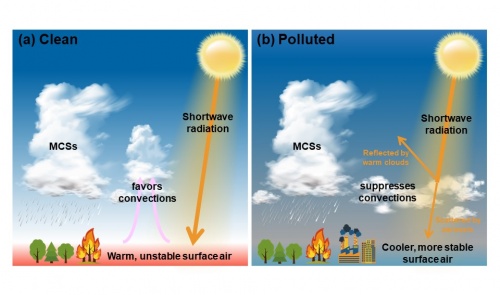Papers:Zhang et al 2020
From atmoschem
Abstract | Precipitation over Southern China in April, largely associated with mesoscale convective systems (MCSs), has declined significantly in recent decades. It is unclear how this decline in precipitation may be related to the concurrent increase of anthropogenic aerosols over this region. Here, using observation analyses and model simulations, we showed that increased levels of anthropogenic aerosols can significantly reduce MCS occurrences by 21% to 32% over Southern China in April, leading to less rainfall. Half of this MCS occurrence reduction was due to the direct radiative scattering of aerosols and the indirect enhancement of non‐MCS liquid cloud reflectance by aerosols, which stabilized the regional atmosphere. The other half of the MCS occurrence reduction was due to the microphysical and dynamical responses of the MCS to aerosols. Our results demonstrated the complex effects of aerosols on MCSs via impacts on both the convective systems and on the regional atmosphere.
Publication | Zhang, L., Fu, T.-M.*, Tian, H., Ma, Y., Chen, J.-P., Tsai, T.-C., Tsai, I.-C., Meng, Z., Yang, X. (2020), Anthropogenic aerosols significantly reduce mesoscale convective system occurrences and precipitation over Southern China in April, Geophys. Res. Lett., doi: 10.1029/2019GL086204. Full text
- This page was last modified on 8 October 2023, at 15:00.
- This page has been accessed 782 times.
